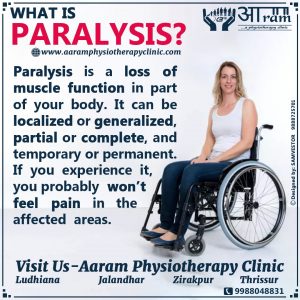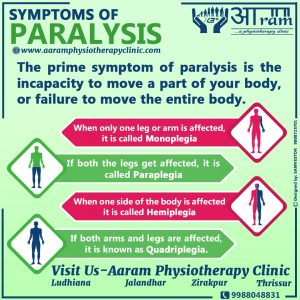What is Paralysis?
Paralysis is a loss of muscle function in part of your body. It can be localized or generalized, partial or complete, and temporary or permanent. Paralysis can affect any part of your body at any time in your life. If you experience it, you probably won’t feel pain in the affected areas.
It is caused by the disruption in the communication of messages between the brain and the body parts. It can occur on either or both sides of the body. It can be restricted or widespread. Paralysis of the legs is called the paraplegia whereas the paralysis of the arms is called quadriplegia.
Paralysis is mainly caused due to strokes or injuries such as a spinal cord injury or broken message transmission system. Other causes of paralysis include Nerve diseases, Autoimmune diseases or Bell’s palsy (affects muscles in the face). Cerebral Palsy also is a main cause of Paralysis.
Paralysis can affect different parts of the body and can be hence classified:
Location: Localised Paralysis are known to affect specific parts of the body. A generalized paralysis is a group of conditions that affect multiple body parts. The types of which include:
- monoplegia, which affects only one arm or leg
- hemiplegia, which affects one arm and one leg on the same side of your body
- paraplegia, which affects both of your legs
- quadriplegia, or tetraplegia, which affects both of your arms and both of your legs
On the basis of Severity, Paralysis can be considered as:
- If you have partial paralysis, you’ll have some or little control over the muscles in the affected body parts
- If you have complete paralysis, you’ll have absolutely no control over the muscles in the affected areas.
The paralysis may or may not be temporary. For example, Bell’s Palsy is a condition that can cause temporary paralysis of your face. Strokes can also temporarily paralyze one side of your body. With time and treatment, you may regain some or all of your feeling and coordination. In other cases, your paralysis may be permanent.
Symptoms of Paralysis:
The symptoms of paralysis are easy to identify. If one experiences paralysis, loss of function in a specific or widespread area of your body can be observed. Sometimes a tingling or numbing sensation can also be experienced before total paralysis sets in. Paralysis also makes it difficult or impossible to control the muscles in the affected body parts.
The prime symptom of paralysis is the incapacity to move a part of your body, or failure to move the entire body. Paralysis can begin all of a sudden or gradually. In some cases, it comes and goes.
Diagnosis:
The doctor is able to diagnose paralysis in few simple steps. There are variations in level of consciousness in the body. You feel confused and dizzy. The body loses coordination. There is change in the vision. There is loss of power or numbness in legs, arms or both. Doctor will conduct tests such as electromyography, imaging scans, CT scans and blood tests to be sure. Paralysis can be easily diagnosed as the loss of function of the muscles in the affected area is evident. For diagnosis of the internal affected body parts, the doctor may recommend imaging studies such as X-rays and CT scans.
The doctor may also recommend lifestyle changes, medications, surgery, or other treatments to help manage potential complications.
Problems because of Paralysis:
Since paralysis can happen to any muscle or group of muscles, many body functions can be affected. Some of the problems that can occur along with paralysis include:
- Problems with blood flow, breathing, and heart rate
- Changes in the normal function of organs, glands, and other tissues
- Changes to muscles, joints, and bones
- Skin injuries and pressure sores
- Blood clots in the legs
- Loss of urine and bowel control
- Sexual problems
- Problems speaking or swallowing
- Behavioural and mood changes
Who is Prone to Paralysis?
Almost anyone and everyone is prone to People who have the following habits in practice are highly prone to Paralysis:
- Smoking
- Inadequate Physical Activity
- High Blood Pressure
- High Cholesterol Levels
- Family History
Treatment for Paralysis:
Usually, physical therapy is used to treat this condition. Treatments such as heat massage, physiotherapy and exercise are done to stimulate the nerves and muscles. Functional Electrical stimulation is used in some cases to offer help to the patient.
Rehabilitation Exercises for Paralysis:
Exercises are one of the most efficient ways to recover from Paralysis, this is because the muscles aren’t weak, they just have a hard time communicating with the brain to get messages for their performance. The point of the exercise is to re-establish the link between the two.
- Easy Pose
- Child Pose
- Half Spinal Twist Pose
- Mountain Pose
- Cat Pose
Daily rehabilitation exercises are highly recommended however it is important to note that even if few reps, they must be done consistently. The consistency is an important key to achieve success.



